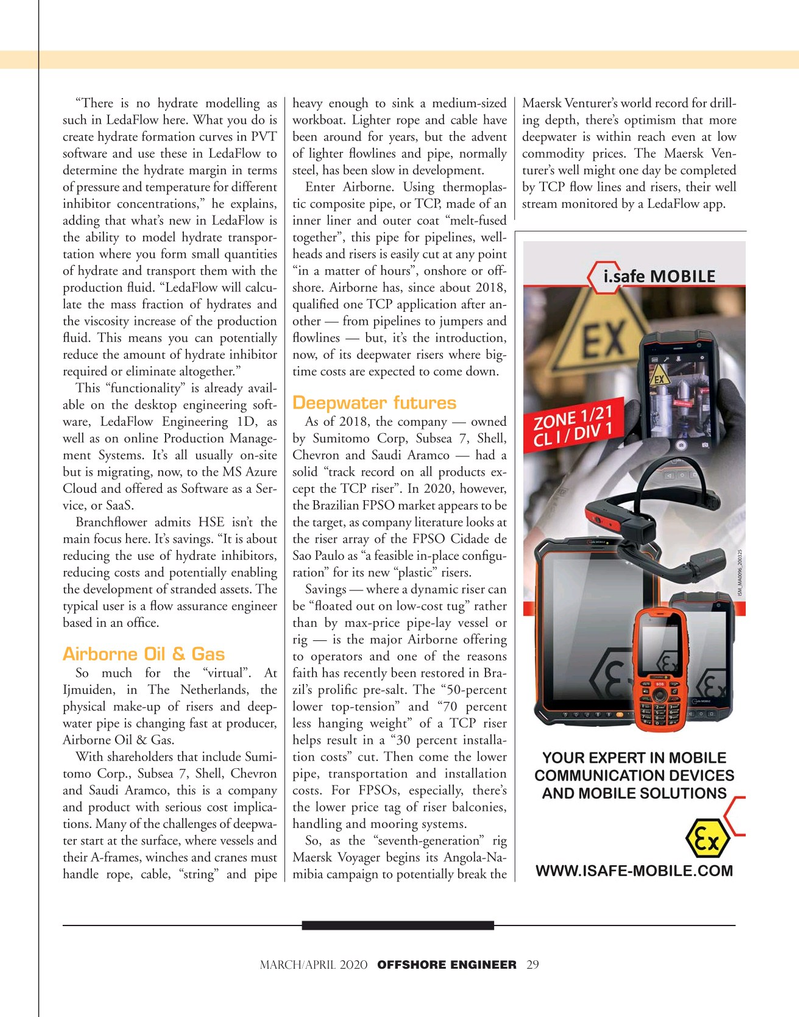
Page 29: of Offshore Engineer Magazine (Mar/Apr 2020)
Offshore Wind Outlook
Read this page in Pdf, Flash or Html5 edition of Mar/Apr 2020 Offshore Engineer Magazine
“There is no hydrate modelling as heavy enough to sink a medium-sized Maersk Venturer’s world record for drill- such in LedaFlow here. What you do is workboat. Lighter rope and cable have ing depth, there’s optimism that more create hydrate formation curves in PVT been around for years, but the advent deepwater is within reach even at low software and use these in LedaFlow to of lighter ?owlines and pipe, normally commodity prices. The Maersk Ven- determine the hydrate margin in terms steel, has been slow in development. turer’s well might one day be completed of pressure and temperature for different Enter Airborne. Using thermoplas- by TCP ?ow lines and risers, their well inhibitor concentrations,” he explains, tic composite pipe, or TCP, made of an stream monitored by a LedaFlow app. adding that what’s new in LedaFlow is inner liner and outer coat “melt-fused the ability to model hydrate transpor- together”, this pipe for pipelines, well- tation where you form small quantities heads and risers is easily cut at any point of hydrate and transport them with the “in a matter of hours”, onshore or off- production ?uid. “LedaFlow will calcu- shore. Airborne has, since about 2018, late the mass fraction of hydrates and quali?ed one TCP application after an- the viscosity increase of the production other — from pipelines to jumpers and ?uid. This means you can potentially ?owlines — but, it’s the introduction, reduce the amount of hydrate inhibitor now, of its deepwater risers where big- required or eliminate altogether.” time costs are expected to come down.
This “functionality” is already avail-
Deepwater futures able on the desktop engineering soft- ware, LedaFlow Engineering 1D, as As of 2018, the company — owned well as on online Production Manage- by Sumitomo Corp, Subsea 7, Shell, ment Systems. It’s all usually on-site Chevron and Saudi Aramco — had a but is migrating, now, to the MS Azure solid “track record on all products ex-
Cloud and offered as Software as a Ser- cept the TCP riser”. In 2020, however, vice, or SaaS. the Brazilian FPSO market appears to be
Branch?ower admits HSE isn’t the the target, as company literature looks at main focus here. It’s savings. “It is about the riser array of the FPSO Cidade de reducing the use of hydrate inhibitors, Sao Paulo as “a feasible in-place con?gu- reducing costs and potentially enabling ration” for its new “plastic” risers. the development of stranded assets. The Savings — where a dynamic riser can typical user is a ?ow assurance engineer be “?oated out on low-cost tug” rather based in an of?ce. than by max-price pipe-lay vessel or rig — is the major Airborne offering to operators and one of the reasons
Airborne Oil & Gas
So much for the “virtual”. At faith has recently been restored in Bra-
Ijmuiden, in The Netherlands, the zil’s proli?c pre-salt. The “50-percent physical make-up of risers and deep- lower top-tension” and “70 percent water pipe is changing fast at producer, less hanging weight” of a TCP riser
Airborne Oil & Gas. helps result in a “30 percent installa-
With shareholders that include Sumi- tion costs” cut. Then come the lower tomo Corp., Subsea 7, Shell, Chevron pipe, transportation and installation and Saudi Aramco, this is a company costs. For FPSOs, especially, there’s and product with serious cost implica- the lower price tag of riser balconies, tions. Many of the challenges of deepwa- handling and mooring systems.
ter start at the surface, where vessels and So, as the “seventh-generation” rig their A-frames, winches and cranes must Maersk Voyager begins its Angola-Na- handle rope, cable, “string” and pipe mibia campaign to potentially break the march/april 2020 OFFSHORE ENGINEER 29

 28
28

 30
30